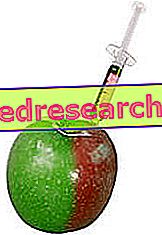What's this
What is selenium?
Selenium is a micronutrient oligomineral with many properties and which performs numerous functions, both for the human or animal organism, and for the vegetable and various bacteria; in the next paragraph we will examine them in depth.

It is mainly contained in foods of animal origin, especially sea fish - as well as iodine - and offal, but is found in variable concentrations also in different cereals, legumes, oilseeds, fruits and vegetables - depending on the concentration in the soil.
Because of its importance, many suggest supplementing the diet with fortified foods, dietary foods or food supplements; however, it should be remembered that selenium can be, at excessive concentrations, potentially toxic.
In the human body, selenium is present in organic form (selenocysteine or selenium-cysteine and selenomethionine or selenium-methionine) and inorganic (selenites and selenates). Most selenium is concentrated in the liver and thyroid gland; contain selenium enzymes that metabolise thyroid hormones and antioxidant type.
Functions
Selenium and antioxidant enzymes
Organic selenium - in the form of selenium-cysteine - is a cofactor of the antioxidant enzymes glutathione peroxidase (GSH-Px) and thioredoxin (Trx) disulfide reductase. Operating in synergy with vitamin E (tocopherol or tocotrienol), the glutathione peroxidase family is responsible for combating the oxidative stress of free radicals - especially reactive oxygen species such as hydrogen peroxide and organic hydroperoxides - on cell membranes: 2 GSH + H2O2 ---- GSH-Px → GSSG + 2 H2O. The thioredoxin disulfide reductase instead, is an enzyme belonging to the class of oxidoreductases which catalyzes the following reaction: thioredoxin + NADP + AD thioredoxin disulfide + NADPH + H +
Selenium, thyroid gland and thyroid hormones
The thyroid and the cells that metabolize its hormones use large amounts of selenium. This plays the role of a cofactor for three of the four types of deiodases or deiodinases, which activate and deactivate various thyroid hormones and their metabolites. The iodases are therefore able to remove electrons from iodides, and iodides from iodothyronines and are closely involved in the regulation of thyroid hormones, participating in the protection of thyrocytes from H2O2 damage - produced by the biosynthesis of thyroid hormone.
The iodothyronines deiodinases contain selenium in the form of selenocysteine; only the iodothyrosine deiodinase, which acts on the last degradation products of the thyroid hormone, does not contain selenium.
Selenium in other proteins
Organic selenium is also contained in other protein elements as selenium-methionine.
Selenium antagonist of mercury
The increase in selenium in the diet reduces the toxicity of low or modest amounts of mercury - and also of other potentially contaminating metals.
The molecular mechanisms of mercury toxicity are based on the irreversible inhibition of selenoenzymes necessary to prevent and reverse oxidative damage to the brain and endocrine tissues.
The red tuna - which although accumulating mercury does not seem to suffer from any form of poisoning - contains, in the blood, high concentrations of antioxidant selenoneine. The molecule is currently the subject of scientific research regarding possible implications in inflammatory and chronic diseases, in oxidative damage and in methylmercury detoxification.
Selenium and enzymes in plants
In plants, selenium can have a defense function, resulting toxic in forages for the animals that consume them. Certain plants are considered indicators of selenium in the soil, because without it they could not grow and develop.
Property
Selenium for metabolic pathologies
Thanks to its ability to protect cell membranes from oxidation - we have seen that it constitutes glutathione peroxidase (GSH-Px) and thioredoxin (Trx) disulfide reductase - selenium has a protective effect against cardiovascular diseases.
Selenium and thyroid hormones
Selenium is necessary for the transformation of thyroxine (T4) into triiodothyronine (T3), and as such plays a major role in supporting thyroid function.
Selenium for Hashimoto's thyroiditis
Selenium can inhibit Hashimoto's autoimmune thyroid disease, in which the thyroid cells are attacked by the immune system because they are identified as foreign.
Intake of 0.2 mg of selenium in the diet can lead to a 21% reduction in anti-TPO antibodies. To learn more, consult the article: Selenium and Thyroid.
Selenium against mercury and other metal contaminants
Furthermore, selenium seems to play an antagonistic role towards heavy metals, such as mercury, cadmium and silver, which is why it can help to hinder the accumulation of these contaminants.



